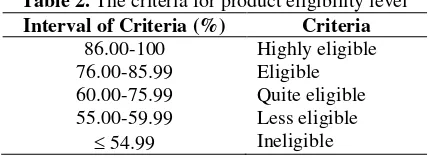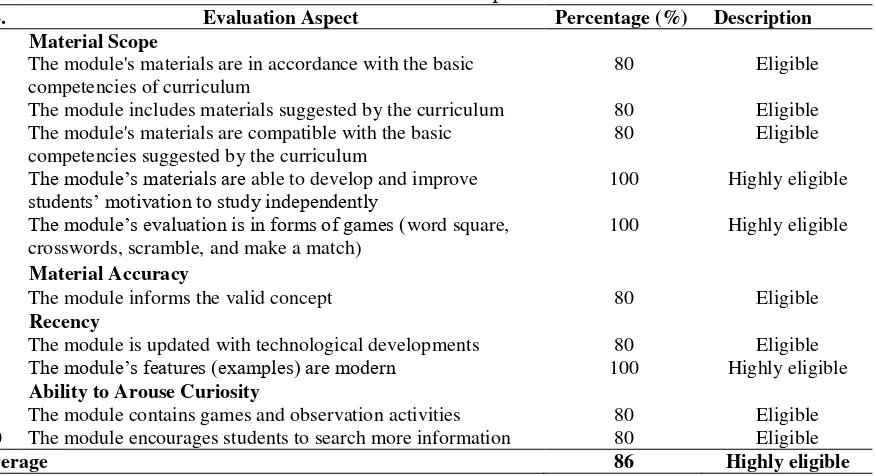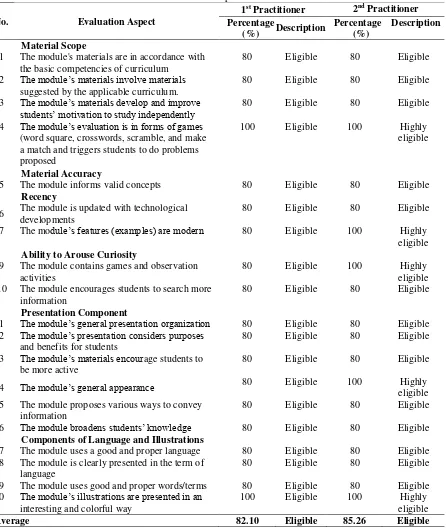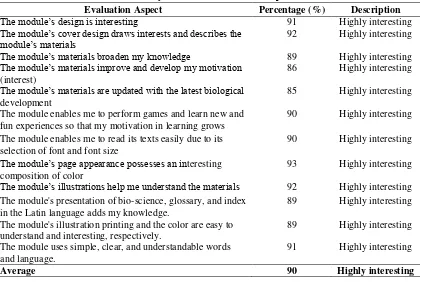Received: 06/02/2018
Revised: 26/03/2018 Accepted: 28/03/2018 JPBI (JURNAL PENDIDIKAN BIOLOGI INDONESIA)
Indonesian Journal of Biology Education
DEVELOPING THE FUN AND EDUCATIVE MODULE IN PLANT
MORPHOLOGY AND ANATOMY LEARNING FOR TENTH GRADERS
Alfi Suciati* and Tabita Adian
Department of Biology Education, University of Borneo Tarakan, North Kalimantan, Indonesia *corresponding e-mail: [email protected]
ABSTRACT
This research aims to examine the eligibility of and responses from expert media, expert material, practitioners and students’ on the ‘Fun and Educative’ biology module. The module was developed in a fun and educative way presenting various educative games. The research development model is using ADDIE model that consists of five phases: Analysis, Design, Development, Implementation, and Evaluation. The data collection technique employed examination of learning media experts, material experts, practitioners (biology teachers), and students. The data of research was analyzed in descriptive-qualitative and descriptive-qualitative ways. The results of evaluation on the module’s eligibility convey that the learning media expert gave 87.69% with the category of ‘highly eligible’, the material expert gave 86.00% with the category of ‘highly eligible', and the practitioners gave 83.68% with the category of ‘eligible'. The students' responses to questionnaires given related to the developed module gave 90.00% with the category of ‘highly interesting'. Based on the results of examination by the media expert, material expert, practitioners, and students, conclude that the module has fulfilled the criteria of good and eligible learning material and can be used for studying biology.
Keywords: anatomy, educative, fun, morphology, plant
© 2018 Department of Biology Education, FTTE, University of Muhammadiyah Malang, Indonesia
INTRODUCTION
The learning process is a process to develop students' potencies and aims to enable students to master materials based on the determined indicators. A good learning process is a well-executed learning process and ability to make students active. To create an effective learning activity, teachers' skills and creativity in compiling lesson plans are certainly demanded. Permana (2015), the learning process must be able to increase the creativity of learners so that more honed skills and produce output that is ready to the challenges of the 21st century. One of the important matters in planning a lesson is the selection of good learning materials and sources. The teaching materials are designed to meet the needs of students to fit the characteristics of the students and based on the student activity plan.
A good learning material includes all learning materials that can be employed to assist teachers in learning processes in the class. Learning materials are designed to help students
to achieve the learning objectives individually. There are various types of learning materials: unwritten learning materials such as audio learning materials and written learning materials such as lesson book, module, handout, student's worksheet, and so on. Pantiwati and Permana (2017), learning materials that have been designed then need to be evaluated, one of them by giving the problem to the learners.
Based on results of observation and interviews at vocational high school 3 Tarakan, the researchers figure out that teachers have applied some different learning methods but the learning performed is still ineffective. This is
triggered by the fact that students’ interest in
biology learning is still low. The assumption is proven as true due to low achievements of students in biology. Besides, learning materials (books) used by students are the copied version of teachers' guidebooks. The books contain materials with boring and vague illustrations that makes students lose attention and interest. The book was bought by a certain publisher, there are no learning materials designed by the teachers themselves.
Meaningful and fun learning is a learning process where a strong and sincere relationship between teachers and students exist (Mulyasa, 2013). Fun learning can be conducted by games integrated with a certain learning material (Dananjaya, 2013). Iten and Petko, (2016) says that learning games can help children to learn more efficiently and better. Noemí and Máximo, (2014) explained that on the use of Game of Island and using an ordinary least squares model, it can conclude that after using the games the most of students have achieved to improve their skills in sustainability, teamwork, solidarity, innovation, creativity, problem-solving, continuous improvement, energy efficiency, mathematical precision, initiative, goal achievement, result orientation, flexibility, and working with the environment.
To help teachers create fun learning, the researchers are interested in making a learning material in the form of fun and educative biology module. The module was designed by combining materials with educative games (crosswords, scramble, make a match, and word square). The module is named “Biology Fun and Educative Module”, used as a teaching material on morphology and anatomical material of plant class X vocational high school 3 Tarakan at the North Kalimantan. The module was designed in a colorful mode to make students more excited and interested in reading. It is also expected to be able to motivate students and help them gain a better score.
METHOD
The type of this research is research and development (R&D). The procedure of research and development of biology module with
educative game refers to the ADDIE model which consists five stages, namely Analysis, Design, Development, Implementation, and Evaluation.
Analysis
This phase involved two aspects that were analyses of curriculum and needs. The curriculum used was the School-Based Curriculum (Kurikulum Tingkat Satuan
Pendidikan/KTSP) with the basic competence
as identifying types of cell, basic tissues, and plant organs. The analysis of needs was conducted by analyzing students and materials. Student analysis is an analysis executed to observe students' characters that are learning an ability, age, learning interest, and experience. Moreover, the material analysis was performed by identifying main materials developed. The main materials developed were planted morphology and anatomy.
Design
Trianto (2007), argues that the designing phase consists of three stages. The first phase, the construction of standard reference test, was performed by compiling questions and models of question presentation used as an evaluation tool for the developed module. The developed module was expected to be fun and educative containing evaluation tests designed in forms of educative games such as word square, crosswords, scramble, and make a match.
The learning media selection suitable for materials and students' characteristics. In this phase of development, the chosen media is in the form of a module. The module enables students to study independently and measure their abilities by themselves (Padmapriya, 2015). The format selection aimed to give the module a more interesting appearance from the aspects of size, font, pictures layout, and content layout. The early design (prototype) of the often aimed to make the words readable.
Development
with the design and produced a module product. After being developed, the product was validated by several experts consisting of material expert, media expert, and practitioners (biology teachers) to gain information of
module’s eligibility.
Implementation
Implementation was a real step to implement the development of the developed product. The developed and validated product (module) was tried out to 32 students (one class). The try-out was conducted by giving the module to students and asking their response to questionnaires given.
Evaluation
Evaluation is the last phase of ADDIE model. In this phase, the researchers analyzed
students’ responses based on the product try-out
and revised the product based on the recommendations and suggestions of experts, practitioners, and students so that the product becoming respondents for this activity were those who had learned materials of plant morphology and anatomy.
Data Collection Instruments
The data collection instruments consisted of module eligibility validation sheet (filled by experts and practitioners) and student’s response questionnaire (filled by students).
Data Analysis Techniques
The questionnaire data about responses of experts (material, media, and practitioner) related to the developed product (module) eligibility were in forms of qualitative and quantitative data. The qualitative data were in forms of critics and suggestions managed to be guided to fix the module. The quantitative data were obtained from scoring by the experts. To conduct the scoring and evaluation, the experts utilized the Likert scale with five intervals and criteria as Table 1.
Table 1. The criteria of validators’ rating
Criteria Rate/Score eligibility percentage. The formulae are as follows:
NP = x 100% (1)
Description: NP: the investigated percentage value; R: the obtained score; SM: the maximum score.
After counting the eligibility percentages, the researchers interpreted the results by
following the criteria of validators’ evaluation
as seen in Table 2.
Table 2. The criteria for product eligibility level
Interval of Criteria (%) Criteria
86.00-100
Based on the criteria presented in Table 2, a product is perceived as eligible if the minimum eligibility average is ≥76. Students' responses towards the developed product were developed into qualitative and quantitative data. The qualitative data were students' critics and suggestions that they were perceived as recommendations to improve the module; while the quantitative data were gained by evaluating and analyzing students' responses by using Riduwan (2011), standard scores that had been modified. The evaluation of students' responses was executed by utilizing the Likert scale with five intervals as shown in Table 3.
The percentage (%) was analyzed by employing Riduwan (2011):
% = Number of scores from data collection x 100% (2) Number of score criteria
The percentage obtained was then categorized as in Table 4.
Table 4. The criteria of students’ response interpretation
Percentage (%) Criteria
0.00-20.00 Highly interesting
20.01-40.00 Less interesting
40.01-60.00 Quite interesting
60.01-80.00 Interesting
80.01- 100 Highly interesting
(Source: Riduwan, 2011).
RESULTS AND DISCUSSION
The module is an effective learning media to improve learning results. By the means of the module, students can be more active in studying since faced to problems and guided to solve the problems by themselves (Chotimah, Susilo, Muhdhar, & Ibrohim, 2017). Before preparing the module, the researchers were initially conducted an analysis in order to make the module able to meet the expectation and need of students. The analysis stage consisted of two
phases: working analysis and need analysis. The activities of module making included the sorting of learning objectives, preparation of materials, conceptualizing of the module and its materials, and the making of modules' appearance design. Then, the draft of module evaluated in terms of its eligibility.
Module’s Eligibility
This evaluation was executed by using questionnaires. Questionnaires used by the material expert, learning media expert, and practitioners to acknowledge the module's eligibility.
Learning Media Experts’ Validation
Based on the results of validation analysis by media experts, it can be observed on Table 5 that the developed module gains the percentage of 87.69%. The percentage was perceived as
‘eligible' by Purwanto (2013). The fun and
educative biology module were also rated as being eligible to be used yet it had to be revised first. Learning media expert validator provided several suggestions, such as module’s covers should be modified in order to be more
interesting, authors of plant’s scientific names
should be added, and the learning indicators had to be made in terms of learning objectives.
Table 5. The results of media expert’s validation
No. Evaluation Aspect Percentage (%) Description Paper of the Developed Product
1 The module's paper is compatible with the printing quality 80 Eligible
2 The paper of module’s cover and content is fine and difficult to ripe so that it provides convenience for readers
100 Highly eligible
Cover Design
3 The module’s cover illustration illustrates the module’s content that is about plant morphology and anatomy
80 Eligible
4 The module’s layout interests readers 80 Eligible
5 The module’s cover illustration describes the module’s content or materials
100 Highly eligible
Content Design
6 The module’s cover illustration describes the module’s content or materials
80 Eligible
7 The module’s material layout eases readers to understand the materials
80 Eligible
8 The module’s material is presented in full of colors and able to increase reading interests
100 Highly eligible
9 The module's evaluation in forms of games creates fun for readers 80 Eligible
10 The module’s content illustration is compatible with the module’s materials
80 Eligible
11 The module’s font and illustration are clear 80 Eligible
12 The module’s cover printing is clean and clear 100 Highly eligible
13 The module’s content printing is clean and clear 100 Highly eligible
Material Expert’s Validation
Based on the analysis of validation from material experts shown in Table 6, it can be concluded that the developed module gets the percentage of 86%. According to Purwanto, (2013), the percentage indicates a high eligibility. The fun and educative biology
module are also perceived as eligible to be used, yet it has to be revised first. The material expert validators stated that the developed biology module could be regarded as good but the sources of several material citations contained by the module should have been added.
Table 6. The results of material experts’ validation
No. Evaluation Aspect Percentage (%) Description
Material Scope
1 The module's materials are in accordance with the basic competencies of curriculum
80 Eligible
2 The module includes materials suggested by the curriculum 80 Eligible
3 The module's materials are compatible with the basic competencies suggested by the curriculum
80 Eligible
4 The module’s materials are able to develop and improve
students’ motivation to study independently 100 Highly eligible
5 The module’s evaluation is in forms of games (word square, crosswords, scramble, and make a match)
100 Highly eligible
Material Accuracy
6 The module informs the valid concept 80 Eligible
Recency
7 The module is updated with technological developments 80 Eligible
8 The module’s features (examples) are modern 100 Highly eligible
Ability to Arouse Curiosity
9 The module contains games and observation activities 80 Eligible
10 The module encourages students to search more information 80 Eligible
Average 86 Highly eligible
First Practitioners’ Validation
Based on the analysis of validation of biology teacher 1 shown by Table 7, it is known that the developed module gets the percentage
of 82.10% and thus it is categorized as ‘eligible’
by Purwanto (2013). The fun and educative biology module is perceived to be able to be used but with revision. The 1st Practitioner stated that the developed biology module had been eligible in quality but there were still mistakes in its content. The practitioner suggested using the same font in terms of its type and size.
Second Practitioner Validation
Based on the analysis of validation of 2nd practitioner displayed on Table 7, it can be observed that the developed module obtains the percentage of 85.5% and thus it can be
categorized as ‘eligible’ but it has to be revised
first. The 2nd practitioner argued that the developed module had been excellent and interesting in terms of appearance and hence it could be expected to enable students to study
the materials of plant morphology and anatomy easier.
Recapitulation of Validators’ Score Percentage
Table 8 indicates that the media expert’ evaluation is 87.69% with the category of
‘eligible’, the material expert’ evaluation is 86% with the category of ‘highly eligible’, and the
practitioners’ evaluation is 83.68% with the
category of ‘eligible’. Therefore, according to
Purwanto (2013) the average score of those three scores is 86.79% indicating that the module is eligible.
Students’ Responses
Table 9 displays the result of analysis of students' responses towards the developed module. The developed fun and educative biology module earns an excellent percentage value as much as 90% and hence fulfills the criteria of students' interest and compatibility
with students’ needs. The module is able to help
percentage value is achieved by the eighth indicator with the percentage value of 93% with
the category of ‘highly interesting’. Purnama
(2010), believes that color is a crucial element to develop learning materials. An interesting content and color composition can attract students to read the developed module. Besides, illustrations can also ease students to comprehend the materials presented. Giving games as an evaluation material and observational activities supporting the materials
can encourage students to be more active instead of only asking them to listen to teachers while studying. Silberman (2006), conveys that students that get learning materials by only listening to teachers earn learning achievement as much as 30% only. To obtain an optimum result, students are suggested to read, observe, listen, and do supporting activities. Pantiwati, Wahyuni, and Permana (2017), learning model with a fun learning module will make students become interested in learning.
Table 7. The results of 1st practitioner validation
No. Evaluation Aspect
1st Practitioner 2nd Practitioner
Percentage
(%) Description
Percentage (%)
Description
Material Scope
1 The module's materials are in accordance with the basic competencies of curriculum
80 Eligible 80 Eligible
2 The module’s materials involve materials suggested by the applicable curriculum.
80 Eligible 80 Eligible
3 The module’s materials develop and improve
students’ motivation to study independently 80 Eligible 80 Eligible
4 The module’s evaluation is in forms of games (word square, crosswords, scramble, and make a match and triggers students to do problems proposed
100 Eligible 100 Highly
eligible
Material Accuracy
5 The module informs valid concepts 80 Eligible 80 Eligible
Recency
6 The module is updated with technological developments
80 Eligible 80 Eligible
7 The module’s features (examples) are modern 80 Eligible 100 Highly
eligible
Ability to Arouse Curiosity
9 The module contains games and observation activities
80 Eligible 100 Highly
eligible 10 The module encourages students to search more
information
80 Eligible 80 Eligible
Presentation Component
11 The module’s general presentation organization 80 Eligible 80 Eligible
12 The module’s presentation considers purposes and benefits for students
80 Eligible 80 Eligible
13 The module’s materials encourage students to be more active
80 Eligible 80 Eligible
14 The module’s general appearance 80 Eligible 100 Highly
eligible 15 The module proposes various ways to convey
information
80 Eligible 80 Eligible
16 The module broadens students’ knowledge 80 Eligible 80 Eligible
Components of Language and Illustrations
17 The module uses a good and proper language 80 Eligible 80 Eligible
18 The module is clearly presented in the term of language
80 Eligible 80 Eligible
19 The module uses good and proper words/terms 80 Eligible 80 Eligible
20 The module’s illustrations are presented in an interesting and colorful way
100 Eligible 100 Highly
eligible
Table 8. The recapitulation of percentage of eligibility aspect scores
No. Validators Scores Percentage (%) Description
1 Media expert 87.69 Highly eligible
2 Material expert 86.00 Highly eligible
3 Practitioners 83.68 Eligible
Average 85.79 Eligible
Table 9. The analysis of results of students’ responses
No. Evaluation Aspect Percentage (%) Description
1 The module’s design is interesting 91 Highly interesting
2 The module’s cover design draws interests and describes the
module’s materials 92 Highly interesting
3 The module’s materials broaden my knowledge 89 Highly interesting
4 The module’s materials improve and develop my motivation (interest)
86 Highly interesting
5 The module’s materials are updated with the latest biological development
85 Highly interesting
6 The module enables me to perform games and learn new and fun experiences so that my motivation in learning grows
90 Highly interesting
7 The module enables me to read its texts easily due to its selection of font and font size
90 Highly interesting
8 The module’s page appearance possesses an interesting composition of color
93 Highly interesting
9 The module’s illustrations help me understand the materials 92 Highly interesting
10 The module's presentation of bio-science, glossary, and index in the Latin language adds my knowledge.
89 Highly interesting
11 The module's illustration printing and the color are easy to understand and interesting, respectively.
89 Highly interesting
12 The module uses simple, clear, and understandable words and language.
91 Highly interesting
Average 90 Highly interesting
CONCLUSION
The conclusions of this research are the module developed in this research is a ‘fun and educative’ biology module. The module provides educative games (word square, crosswords, scramble, and make a match) as evaluation materials in order not to bore students. The module is also equipped with interesting and colorful pictures and illustrations
to draw students’ interest in reading (user
-friendly). In terms of language use, the module has obeyed the Indonesian standardized rules by not using any local language enabling students to understand the module easily despite their possibilities for having the different background.
The developed module’s quality is determined by the eligibility standards by experts (media and material), practitioners
(biology teachers) and students’ responses. The
result of media expert’s validation of the
developed module shows gain category highly eligible, the material expert's and the practitioners' validation of the developed
module shows gain category eligible, and the result of analysis on students responses of the developed module shows gain category highly interesting.
ACKNOWLEDGMENT
Thanks to all experts/practitioners who have become validators in the developing of this module. We are also thankful to headmaster and teachers of Vocational High School 3 Tarakan, at the North Kalimantan who provided place and facilities for this research.
REFERENCES
Chotimah, H., Susilo, H., Muhdhar, M. H. I. A., & Ibrohim. (2017). Development of biology modules with think pair share strategy as an effort to improve cognitive learning outcomes of vocational students.
International Journal of Research and
Review, 4(June), 6–13. Retrieved from
Dananjaya, U. (2013). Media pembelajaran
aktif. Bandung: Nuansa Cendekia.
Iten, N., & Petko, D. (2016). Learning with serious games: Is fun playing the game a predictor of learning success? British
Journal of Educational Technology, 47(1),
151–163. https://doi.org/10.1111/bjet.1222 6
Mulyasa, E. (2013). Pengembangan dan
implementasi kurikulum 2013.
Noemí, P. M., & Máximo, S. H. (2014). Educational games for learning. Universal
Journal of Educational Research, 2(3),
230–238. https://doi.org/10.13189/ujer.201 4.020305
Padmapriya, P. V. (2015). Effectiveness of self learning modules on achievement in biology among secondary school students.
International Journal of Education and
Psychological Research (IJEPR), 4(2),
44–46.
Pantiwati, Y., & Permana, F. H. (2017). Analisis butir soal oleh mahasiswa S1 Pendidikan Biologi Universitas Muham-madiyah Malang (UMM) Berdasarkan PISA dan Taksonomi Bloom Revisi. In
Seminar Nasional Pendidikan Berke-majuan dan Menggembirakan (The Prog-ressive & Fun Education Seminar) ke-2
(pp. 707–716). Surakarta: Universitas Muhammadiyah Surakarta. Retrieved from https://publikasiilmiah.ums.ac.id/xmlui/ha ndle/11617/9550
Pantiwati, Y., Wahyuni, S., & Permana, F. H. (2017). Instructional model of natural science in junior high schools, Batu - Malang. Journal of Education and
Practice, 8(8), 117–123. Retrieved from
https://eric.ed.gov/?id=EJ1139066
Paulo, J. C., & Cruz, D. (2015). Development of an experimental science module to
im-prove middle school students’ integrated science process skills. In Proceedings of
the DLSU Research Congress (Vol. 3, pp.
1–6). Retrieved from http://www.dlsu.edu. ph/conferences/dlsu_research_congress/20 15/proceedings/lli-proceedings-2015.asp Permana, F. H. (2015). Pengembangan buku
ajar biologi berbasis blended learning sebagai bekal hidup di abad 21 untuk mahasiswa S1 Kimia FMIPA UM. In
Prosiding Seminar Nasional Pendidikan Biologi 2015, yang diselenggarakan oleh Prodi Pendidikan Biologi FKIP Uni-versitas Muhammadiyah Malang, tema:
“Peran Biologi dan Pendidikan Biologi
dalam Menyiapkan Generasi Unggul dan
Berdaya Saing Global”, Malang, 21 (pp.
50–61). Malang: Universitas Muhamma-diyah Malang. Retrieved from http://re search-report.umm.ac.id/index.php/ resear ch-report/article/view/441/665
Purnama, S. (2010). Elemen warna dalam pengembangan multimedia pembelajaran agama Islam. Jurnal Al-Bidayah Jurusan
Teknologi Pembelajaran Fakultas
Tarbiyah UIN, 2(2), 113–129.
Purwanto, M. N. (2013). Prinsip-prinsip dan
teknik evaluasi pengajaran. Bandung: PT
Remaja Rosdakarya Offset.
Riduwan. (2011). Skala pengukuran
variabel-variabel penelitian. Bandung: Alfabeta.
Sejpal, K. (2013). Modular method of teaching.
International Journal for Research in Education, 2(2), 169–171.
Silberman, M. L. (2006). Active learning: 101
cara belajar siswa aktif. Bandung:
Nuansa.
Trianto. (2007). Model-model pembelajaran
inovatif berorientasi konstruktivistik.




